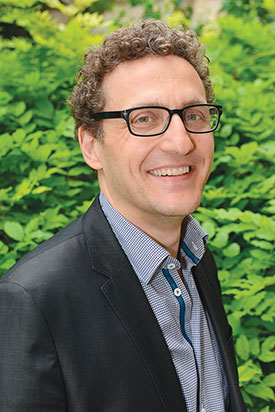Maxime Dahan
DOI: 10.1063/PT.3.4099
Maxime Dahan, a pioneer in single-molecule biophysics, passed away unexpectedly at age 46 on 29 July 2018 in his home near Paris. Maxime was the director of the Curie Institute’s physical chemistry unit and a research director at CNRS.

Maxime Dahan
© ALEXANDRE LESCURE/INSTITUT CURIE

Born on 15 January 1972 in Paris, Maxime completed his undergraduate studies in 1993 at the École Polytechnique. He received his master’s in quantum physics at the École Normale Supérieure (ENS) in 1994 and his PhD, under the supervision of Christophe Salomon, from the school’s Kastler Brossel Laboratory in 1997.
While working on his thesis, Maxime was the first to observe the predicted Bloch oscillations for a cold atom subjected to both a constant force and a periodic potential. During that same time, as a member of Jean Dalibard’s team, he obtained a second spectacular result: a demonstration of giant elastic and inelastic collision cross sections between ultracold and polarized cesium atoms due to zero-energy resonance. For those remarkable achievements, he received a Young Researcher Award special mention in 1997 from the French Society of Physics.
For his postdoctoral training, Maxime switched to the newly developing field of single-molecule biophysics. It was a big departure, and a bold move, from his education in atomic physics. He joined the lab of Daniel Chemla and one of us (Weiss) at Lawrence Berkeley National Laboratory in 1998 and began work on developing the single-molecule fluorescence resonance energy transfer (smFRET) methodology and on applying quantum dots (QDs) to biological imaging.
Although he lacked formal training in biology and chemistry, Maxime managed in no time to make seminal contributions to both projects. Using smFRET, he demonstrated Förster distance dependence on a series of doubly labeled dsDNA molecules, identified molecular subpopulations, followed an enzymatic reaction, measured DNA hairpin dynamics, and conducted the first single-molecule protein-folding experiment. He also characterized QD photophysical properties and demonstrated their utility for time-gated contrast enhancement in biological imaging.
In 1999 Maxime became a research director at CNRS and established an optics and biology group at the Kastler Brossel Laboratory. Using fluorescent probes, in particular QDs, he developed the means to visualize cellular processes at the single-molecule level. For that work, in 2006 he received both a CNRS Bronze Medal and the Jacques Herbrand Prize of the French Academy of Sciences.
With a deep understanding of what biological questions could be studied with QD probes, Maxime established an extremely powerful and productive partnership with another of us (Triller) in the ENS biology department. Together the collaboration studied the lateral diffusion of glycine receptors (GlyRs) and analyzed their lateral dynamics in the neuronal membranes of living cells. The researchers were able to characterize multiple diffusion domains in relation to GlyR localization and show that GlyRs enter into the synapse. Their groundbreaking results, published in Science in 2003, led to many joint follow-up investigations that opened up a new field in neuronal biology.
Maxime’s interest in cellular processes led him to design a microfluidics system that allows for controlled chemical stimulation of single cells. That work earned him two patents and led to his cofounding of Alvéole, a successful startup in cell micropatterning technologies, in 2010.
In 2011 Maxime went on sabbatical to the Howard Hughes Medical Institute’s Janelia Research Campus in Ashburn, Virginia. There he headed the Transcription Imaging Consortium with Xavier Darzacq, Rob Singer, Robert Tjian, and Carl Wu. They laid the groundwork for live-cell transcription imaging that continues today in laboratories around the world.
Maxime returned to Paris in 2013 to head the physical chemistry unit at the Curie Institute. He gave new impetus to the department by bringing his expertise in single-molecule tracking at the cellular level and by opening the laboratory to new fields such as quantitative immunohematology. He was an excellent and respected director who paid particular attention to young researchers, shared his enthusiasm, and was a leader for those working at the physics–biology interface.
In his own research, Maxime made revolutionary contributions in the study of the cell nucleus, including the aggregation dynamics of RNA polymerase II and the search dynamics of transcription factors. He also had beautiful achievements in magnetogenetic manipulation at the cellular level, particularly in the study of Rac-GTPase signaling. Maxime’s recent work on the use of virtual reality to improve visualization of cells and tissues in breast cancer surgery and on chromosome dynamics was tragically interrupted.
Maxime was a fount of seemingly unlimited ideas and many exciting projects. He was cheerful, friendly, positive, and forward-looking. He is best described by the Yiddish word mensch—a person of integrity and honor. He had excellent experimental skills, great fluency in theoretical concepts, and remarkable intellectual curiosity. He was respectful and collegial to his mentors, mentees, and colleagues. Exposed to many life experiences across the globe, he wholeheartedly embraced the “world citizen” concept. His secure path to a stellar scientific career was abruptly cut short by his sudden and premature death. It is a great loss to his family, friends, and the scientific community. He is dearly missed.
We thank Michelle Dahan Hoffman, David Bensimon, Xavier Darzacq, Edith Heard, Jacques Prost, Robert Singer, Robert Tjian, and Carl Wu for their assistance.
More about the Authors
Claude Cohen-Tannoudji. École Normale Supérieure, Paris, France.
Antoine Triller. École Normale Supérieure, Paris, France.
Shimon Weiss. University of California, Los Angeles.




